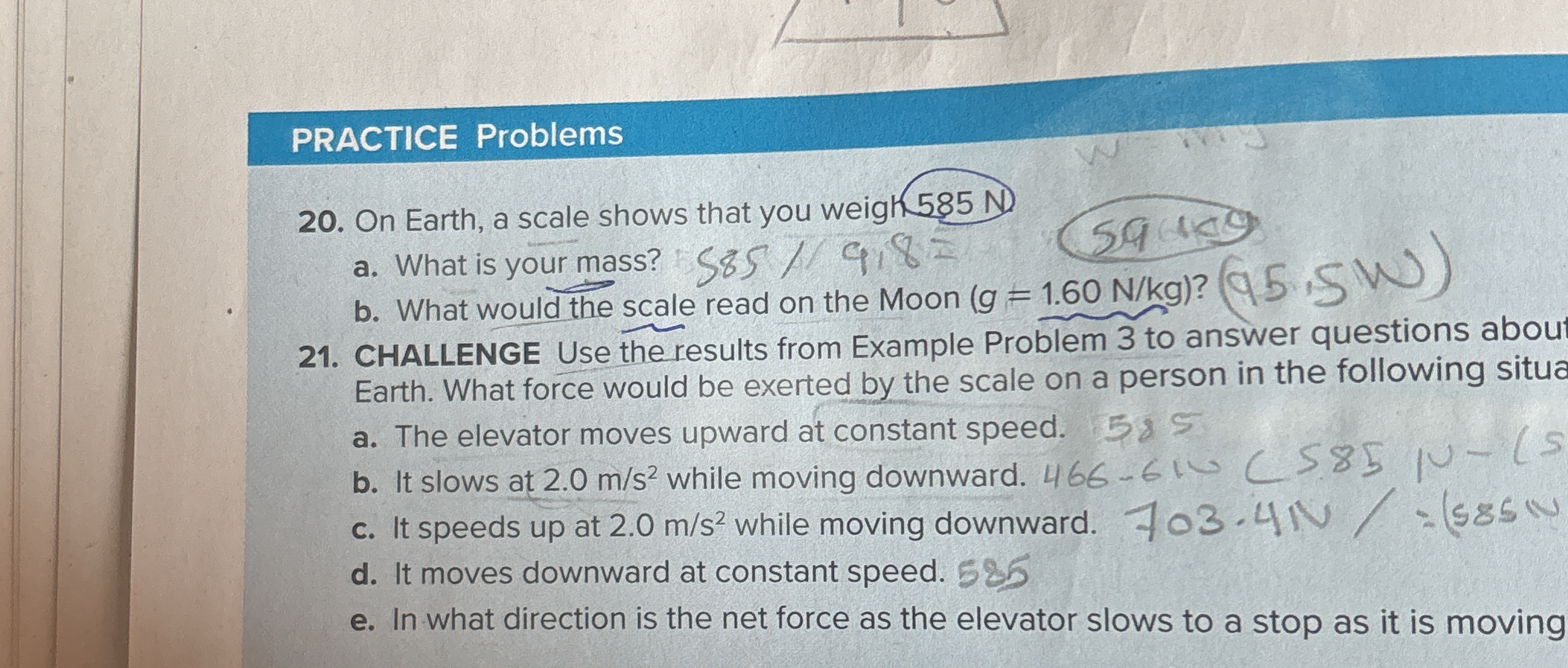On Earth, a scale shows that you weigh 585 N. a. What is your mass? b. What would the scale read on the Moon (g = 1.60 N/kg)? 21. Use the results from Example Problem 3 to answer q... On Earth, a scale shows that you weigh 585 N. a. What is your mass? b. What would the scale read on the Moon (g = 1.60 N/kg)? 21. Use the results from Example Problem 3 to answer questions about Earth. What force would be exerted by the scale on a person in the following situations: a. The elevator moves upward at constant speed. b. It slows at 2.0 m/s² while moving downward. c. It speeds up at 2.0 m/s² while moving downward. d. It moves downward at constant speed. e. In what direction is the net force as the elevator slows to a stop?

Understand the Problem
The question is asking for calculations related to weight and mass on Earth and the Moon, as well as forces experienced in the context of an elevator's movement. It presents different scenarios that require the application of physics principles.
Answer
Mass: $59.7 \, \text{kg}$; Weight on Moon: $95.5 \, \text{N}$. Forces: $585 \, \text{N}$ (upward at constant speed), $466.6 \, \text{N}$ (slowing downward), $703.4 \, \text{N}$ (speeding downward), $585 \, \text{N}$ (downward constant speed). Net force direction: Upward.
Answer for screen readers
a. Mass: $59.7 , \text{kg}$
b. Weight on the Moon: $95.5 , \text{N}$
a. Elevator moving upward at constant speed: $585 , \text{N}$
b. Elevator slowing at $2.0 , \text{m/s}^2$ while moving downward: $466.6 , \text{N}$
c. Elevator speeding up at $2.0 , \text{m/s}^2$ while moving downward: $703.4 , \text{N}$
d. Elevator moving down at constant speed: $585 , \text{N}$
e. Net force direction: Upward
Steps to Solve
- Finding Mass on Earth
To find mass from weight, we use the formula: $$ \text{Weight} = \text{mass} \times g $$ where $g$ is the acceleration due to gravity on Earth, approximately (9.81 , \text{N/kg}). Rearranging the formula gives: $$ \text{mass} = \frac{\text{Weight}}{g} $$ Substituting your weight: $$ \text{mass} = \frac{585 , \text{N}}{9.81 , \text{N/kg}} \approx 59.7 , \text{kg} $$
- Finding Weight on the Moon
The weight on the Moon can be calculated using the same formula, using the Moon’s gravitational acceleration, (g = 1.60 , \text{N/kg}): $$ \text{Weight}{\text{moon}} = \text{mass} \times g $$ Substituting in: $$ \text{Weight}{\text{moon}} = 59.7 , \text{kg} \times 1.60 , \text{N/kg} \approx 95.5 , \text{N} $$
- Analyzing Forces in an Elevator
- a. Elevator moving upward at constant speed:
The scale reads the normal force, which equals your weight: $$ F = 585 , \text{N} $$
- b. Elevator slowing at (2.0 , \text{m/s}^2) while moving downward:
Calculate the effective acceleration: $$ F = m(g - a) = 59.7 , \text{kg} \times (9.81 - 2.0) \approx 466.6 , \text{N} $$
- c. Elevator speeding up at (2.0 , \text{m/s}^2) while moving downward:
Here, you add acceleration to gravity: $$ F = m(g + a) = 59.7 , \text{kg} \times (9.81 + 2.0) \approx 703.4 , \text{N} $$
- d. Elevator moving downward at constant speed:
Again, the scale reads your weight: $$ F = 585 , \text{N} $$
- e. Net force direction as elevator slows to a stop:
When the elevator slows down, it experiences an upward net force since deceleration opposes gravity.
a. Mass: $59.7 , \text{kg}$
b. Weight on the Moon: $95.5 , \text{N}$
a. Elevator moving upward at constant speed: $585 , \text{N}$
b. Elevator slowing at $2.0 , \text{m/s}^2$ while moving downward: $466.6 , \text{N}$
c. Elevator speeding up at $2.0 , \text{m/s}^2$ while moving downward: $703.4 , \text{N}$
d. Elevator moving down at constant speed: $585 , \text{N}$
e. Net force direction: Upward
More Information
Your weight on Earth is due to gravity acting on your mass. On the Moon, with a weaker gravitational pull, your weight is reduced. The varying forces in the elevator depend on its acceleration relative to gravity.
Tips
- Confusing weight with mass. Remember that weight is a force, while mass is a measure of matter.
- Neglecting to account for the direction of forces when calculating net force in scenarios involving acceleration.
AI-generated content may contain errors. Please verify critical information